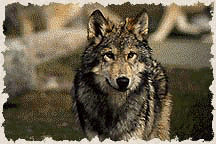Initial reports indicate that the Yellowstone wolf population decreased during 2005, and stopped growing. Biologists had predicted this even though hunters, ranchers and anti wolf activists have argued, and even predicted that the population would grow uncontrollably and get out of hand.
Although unclear, the drop in wolf numbers during the 2005 season is most likely due to parvo virus, which killed the majority of pups born earlier this last spring. Only 19 pups survived into December compared to the usual 50 or 60. As a result the Park wolf population has dropped from 171 wolves in 16 packs to an unofficial 113 +/- 2 wolves in 11-13 packs.
30 Day Early Winter Study Period Ends
The early winter 30 day study period concluded this past week, and Doug Smith has reported that the Slough Creek pack has once again predated primarily on bull elk. The poor condition of many of the bulls taken by wolves was surprising and difficult to understand since the northern range elk population was supposedly down due to predators. With lower elk numbers, we would expect the surviving elk to be strong and well nourished.
“The northern herd is fast becoming a geriatric elk population,” said Tom Lemke, a biologist for the Montana Department of Fish, Wildlife and Parks. The average age of elk harvested during 2004’s (Dec. Jan.) late winter hunt at Gardiner hit a record high of 8.2 years for cows and 9.1 years for bulls. Ten years ago, the average was 6.2 years for cows and 5.9 for bulls. Statewide, the average elk is 4 or 5 years old. “It’s beyond anything we’ve seen before,” Lemke said. “It’s incredible to have 50 percent of the animals be 9 years old or older.”
Although numbers have fluctuated greatly over the decades, since 1995 the overall size has declined steadily from about 19,000 to about 9,500. Hunters and anti wolf activists have been quick to blame wolves, but research indicates that other factors could be responsible.
A new study has shown that 70 to 75 percent of radio-tagged elk calves die in their first year — 55 to 60 percent were killed by grizzly and black bears, 10 to 15 percent by coyotes and the remainder by wolves.
Another recent study indicates that hunting by humans, combined with the past 8-9 year drought, could be a major reason for the decline. “Climate and harvest rate are justified explanations for most of the elk decline,” said the study by Doug Smith and Daniel Stabler, of Yellowstone’s Center for Resources, and John Vucetich, of Michigan Tech University.
That study, which was published in the scientific journal “Oikos”, noted that although the region has been in a drought, including mild winters for the past 8-9 years,, dry summers have reduced the availability and quality of food.
The study also found that wolves tend to take very young or very old elk, while human hunters harvest many prime animals. The authors created mathematical models that found that elk killed by wolves likely were mostly “compensatory” deaths, or animals that would have died anyway due to natural causes.
Field teams during the 30 day early winter study period documented poor bone marrow in the majority of elk predated on by wolves which suggests a lack of food, or poor grazing conditions throughout the Northern Range.
In past years, this has not occured until the late winter 30 day study period in March, after the elk have survived most of the winter on body fat. The Hellroaring Pack reportedly killed only 6 elk during the 30 day study period, but were observed scavenging gut piles left by hunters just outside the Northern border. Field teams documented the Leopold Pack predated on a mixture of calves, cows and bulls.

